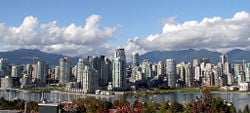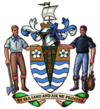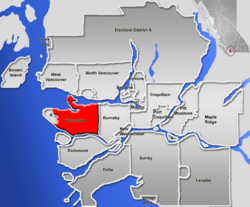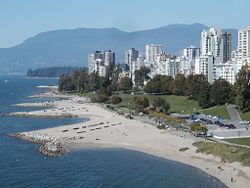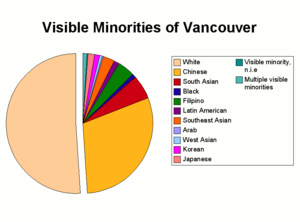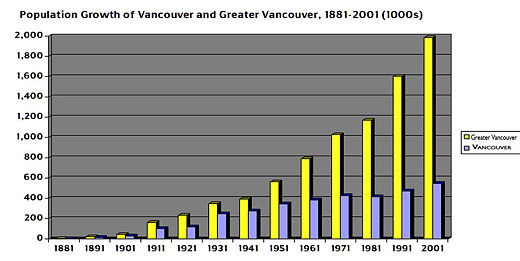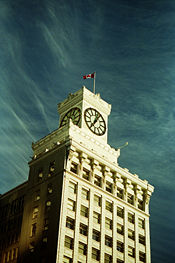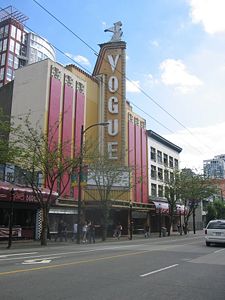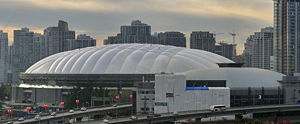Vancouver
| Vancouver | |||
| — City — | |||
| City of Vancouver | |||
| Downtown Vancouver | |||
|
|||
| Motto: "By Sea, Land, and Air We Prosper" | |||
| Location of Vancouver within the Greater Vancouver Regional District in British Columbia, Canada | |||
| Coordinates: 49°15′N 123°6′W | |||
|---|---|---|---|
| Country | Canada | ||
| Province | |||
| Region | Lower Mainland | ||
| Regional District | Metro Vancouver | ||
| Incorporated | 1886 | ||
| Named for | Captain George Vancouver | ||
| Government | |||
| - Mayor | Gregor Robertson (Vision Vancouver) | ||
| Area | |||
| - City | 114.97 km² (44.4 sq mi) | ||
| - Metro | 2,878.52 km² (1,111.4 sq mi) | ||
| Elevation | 0-152 m (0-501 ft) | ||
| Population (2011 Census)[1] | |||
| - City | 603,502 (8th) | ||
| - Density | 5,249/km² (13,594.8/sq mi) | ||
| - Metro | 2,313,328 (3rd) | ||
| - Demonym | Vancouverite | ||
| Time zone | PST (UTC−8) | ||
| - Summer (DST) | PDT (UTC−7) | ||
| Postal code span | V5K to V6Z | ||
| Area code(s) | 604, 778 | ||
| NTS Map | 092G03 | ||
| GNBC Code | JBRIK | ||
| Website: City of Vancouver | |||
Vancouver is the largest city in the province of British Columbia (B.C.), Canada. It is ranked as one of the most beautiful cities in the world as a result of its scenic location between the Pacific Ocean and B.C.'s coastal mountains.[2] A 2006 study found that Vancouver had the third highest quality of living in the world, after Zürich and Geneva.[3] However, it was also ranked the second most expensive city in which to live in Canada after Toronto.[4]
The city of Vancouver is named after Captain George Vancouver, an English explorer. It was first settled in the 1860s as a result of immigration caused by the Fraser Canyon Gold Rush, particularly from the United States, although many immigrants did not remain after the rush. The city developed rapidly from a small lumber mill town into a metropolitan centre following the arrival of the transcontinental railway in 1887. The Port of Vancouver became internationally significant after the completion of the Panama Canal, which reduced freight rates in the 1920s and made it viable to ship export-bound prairie grain west through Vancouver.[5] It has since become the busiest seaport in Canada, and exports more cargo than any other port in North America.[6] Its economy has traditionally relied on British Columbia's resource sectors: forestry, mining, fishing and agriculture. However, Vancouver's economy has diversified over time. Today, Vancouver has a growing tourism industry, for example, and has become the third-largest film production centre in North America, after Los Angeles and New York City, earning it the nickname "Hollywood North".[7] More recently, Vancouver has had an expansion in high-tech industries, most notably video game design.
In 2006, the city of Vancouver had a population of 587,891,[8] while the Greater Vancouver Regional District (GVRD), has a population of 2,180,737.[9] Greater Vancouver is the largest metropolitan area in western Canada and the third largest in the country.[10] Vancouver is ethnically diverse, with more than half of its residents having a first language other than English.[11] The city is growing rapidly, and the GVRD population is projected to reach 2.6 million by 2020.[12] A resident of Vancouver is called a "Vancouverite."
Origins of the city
Archaeological records indicate that the presence of Aboriginal peoples in the Vancouver area dates back 4,500–9,000 years.[13][14] The coastline of present-day Point Grey was first explored in 1791 by José María Narváez of Spain, followed by George Vancouver, who also explored the inner harbor of Burrard Inlet in 1792 and gave various places British names.[15]
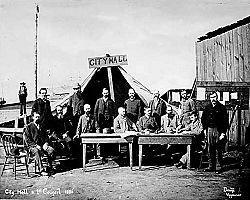
The explorer and North West Company trader Simon Fraser and his crew were the first Europeans known to have set foot on the site of the present-day city. In 1808, they descended the Fraser River perhaps as far as Point Grey, near the University of British Columbia.[17]
The Cariboo Gold Rush of 1861 brought 25,000 men, mainly from California, to the mouth of the Fraser River and what would become Vancouver.[18] The first European settlement was established in 1862 at McLeery's Farm on the Fraser River, just east of the ancient village of Musqueam in what is now Marpole. A sawmill established at Moodyville (now the City of North Vancouver) in 1863 began the city's long relationship with lumbering, and was quickly followed by mills on the south shore of the inlet owned by Captain Edward Stamp. Stamp, who had begun lumbering in the Port Alberni area, first attempted to run a mill at Brockton Point, but difficult currents and reefs forced the relocation of the operation to a point near the foot of Gore Street, known as Hastings Mill. The mill formed the nucleus around which Vancouver formed. The mill's central role in the city waned after the arrival of the Canadian Pacific Railway (CPR) in the 1880s, but it nonetheless remained important to the local economy until it closed in the 1920s.[19]
The settlement grew up quickly around the original makeshift tavern established by “Gassy” Jack Deighton in 1867 on the edge of the Hastings Mill property, which became known as Gastown.[20] In 1870, the colonial government surveyed the settlement and laid out a townsite, renamed “Granville,” in honor of the then British Secretary of State for the Colonies, Granville Leveson-Gower, 2nd Earl Granville. This site, with its natural harbor, was eventually selected as the terminus for the Canadian Pacific Railway to the disappointment of Port Moody, New Westminster and Victoria, all of which had vied to be the railhead. The building of the railway was among the preconditions for British Columbia joining Confederation in 1871.
The City of Vancouver was incorporated on April 6, 1886, the same year that the first transcontinental train arrived. The name, honoring George Vancouver, was chosen by CPR president William Van Horne, who arrived in Port Moody to establish the CPR terminus recommended by Henry John Cambie. A massive "slash burn" (clearing fire) broke out of control on June 13, 1886, razing the entire city. It was quickly rebuilt, and the Vancouver Fire Department was established that same year.[19] From a settlement of 1,000 people in 1881, Vancouver's population grew to over 20,000 by the turn of the century and 100,000 by 1911.[21]
During the 1898 Klondike Gold Rush, Vancouver merchants sold a great deal of equipment to prospectors.[18] One of those merchants, Charles Woodward, had opened the first Woodward's store at what is now Georgia and Main Streets in 1892 and, along with Spencer's and the Hudson's Bay Company department stores, formed the dominant core of the city's retail sector for decades.[22]
The economy of early Vancouver was dominated by large companies such as the CPR, which had the capital needed for the rapid development of the new city. Some manufacturing did develop, but the resource sector was the backbone of Vancouver's economy, initially with logging, and later with exports moved through the seaport, where commercial traffic constituted the largest economic sector in Vancouver by the 1930s.[23]
The dominance of the economy by big business was accompanied by an often militant labor movement. The first major sympathy strike was in 1903 when railway employees struck against the CPR for union recognition. Labor leader Frank Rogers was killed while picketing at the docks by CPR police during that strike, becoming the movement's first martyr.[24] Canada's first general strike occurred following the death of another labor leader, Ginger Goodwin, in 1918, at the Cumberland coal mines on Vancouver Island.[25] A lull in industrial tensions through the later 1920s came to an abrupt end with the Great Depression. Most of the 1930s strikes were led by Communist Party organizers.[26] That strike wave peaked in 1935 when unemployed men flooded the city to protest conditions in the relief camps run by the military in remote areas throughout the province. After two tense months of daily and disruptive protesting, the relief camp strikers decided to take their grievances to the federal government and embarked on the On-to-Ottawa Trek.[27]
Other social movements, such as the first-wave feminist, moral reform, and temperance movements were also influential in Vancouver's development. Mary Ellen Smith, a Vancouver suffragist and prohibitionist, became the first woman elected to a provincial legislature in Canada in 1918.[28] Alcohol prohibition began in the First World War and lasted until 1921, when the provincial government established its control over alcohol sales, which still persists today.[29] Canada's first drug law came about following an inquiry conducted by the federal Minister of Labour and future Prime Minister, William Lyon Mackenzie King. King was sent to investigate damages claims resulting from a riot when the Asiatic Exclusion League led a rampage through Chinatown and Japantown. Two of the claimants were opium manufacturers. A federal law banning the manufacture, sale, and importation of opium for non-medicinal purposes was soon passed based on these revelations.[30]
Amalgamation with Point Grey and South Vancouver gave the city its final contours not long before taking its place as the third largest metropolis in the country. As of 1 January 1929, the population of the enlarged Vancouver was 228,193 and it filled the entire peninsula between the Burrard Inlet and the Fraser River.[31]
Geography
The original vegetation of most of Vancouver and its suburbs was dense temperate rain forest, consisting of Pinophyta conifers with scattered pockets of maple and alder, as well as large areas of swampland (even in upland areas, due to poor drainage).[32][33]
The conifers were a typical coastal British Columbia mix of Sitka Spruce, Western red cedar, Western Hemlock, Douglas-fir, and yew, and are thought to have been the greatest concentration of the largest of these trees on the entire British Columbia Coast. Only in Seattle's Elliott Bay did the trees rival those of Burrard Inlet and English Bay in size. The largest trees in Vancouver's old-growth forest were in the Gastown area, where the first logging occurred, and on the south slopes of False Creek and English Bay, especially around Jericho Beach. The forest in Stanley Park is mostly second and third growth, and evidence of old-fashioned logging techniques such as springboard notches can still be seen there.
A diverse collection of plants and trees were imported from other parts of the continent and from points across the Pacific, and can be found growing throughout Vancouver and the Lower Mainland. Various species of palm trees have proven hardy in this climate and are a common sight, as are large numbers of other exotic trees such as the monkey puzzle tree, the Japanese Maple, and various flowering exotics such as magnolias, azaleas, and rhododendrons. Many rhododendrons have grown to immense sizes, as have other species imported from harsher climates in Eastern Canada or Europe. The native Douglas Maple can also attain a tremendous size. Many streets in the city are lined with flowering varieties of Japanese cherry trees that were donated by Japan, starting in the 1930s.[34] Certain areas of West Vancouver that have the right soil requirements are home to the Arbutus menziesii tree.
Vancouver has an area of 114 square kilometres (44 sq mi), including both flat and hilly ground. Vancouver is adjacent to the Strait of Georgia, a body of water that is shielded from the Pacific Ocean by Vancouver Island. It is in the Pacific Time Zone (UTC-8) and the Pacific Maritime Ecozone. The city itself forms part of the Burrard Peninsula, lying between Burrard Inlet to the north and the Fraser River to the south.
Vancouver is renowned for its scenery and has one of the largest urban parks in North America, Stanley Park.[35] The North Shore Mountains dominate the cityscape, and on a clear day scenic vistas include the snow-capped volcano Mount Baker in the State of Washington to the southeast, Vancouver Island across the Strait of Georgia to the west and southwest, and the Sunshine Coast to the northwest.[36]
Vancouver's climate is unusually temperate by Canadian standards; its winters are the fourth warmest of Canadian cities monitored by Environment Canada after nearby Victoria, Nanaimo, and Duncan, all of which are on Vancouver Island. Vancouver has daily minimum temperatures falling below 0 °C (32 °F) on an average of 46 days per year and below -10 °C (14 °F) on only two days per year. The average annual precipitation is about 1,219 millimetres (48 in), though this varies dramatically throughout the city due to the topography.[36] Summer months are quite sunny with moderate temperatures, tempered by sea breezes. The daily maximum averages 22 °C (72 °F) in July and August, although temperatures sometimes rise above 26 °C (78 °F).[37] The summer months are often very dry, resulting in moderate drought conditions a few months of the year. In contrast, more than half of all winter days receive measurable precipitation. On average, snow falls on only eleven days per year, with only three days receiving six or more centimetres (2.5 in or more).
The air quality in the city has been generally improving [38] Some actions have been taken by various levels of government to limit the problem, such as reducing automobile emissions by vehicle emissions testing. Air quality in the Fraser Valley often suffers as Vancouver's pollution is blown in that direction and "boxed in" by the mountains. The number of cars in the city has been rising with population growth, but car ownership and the average distance driven by the city's car owners have been falling in the past decade. Vancouver is the only major Canadian city where the average daily commute time has shortened in the last ten years, in part due to the residents increasingly choosing to walk or bicycle.[39]
Demographics
City planners in the late 1950s and 1960s deliberately encouraged the development of high-rise residential towers in Vancouver's West End of downtown, resulting in a compact urban core amenable to public transit, cycling, and pedestrian traffic. Vancouver's population density on the downtown peninsula is 121 people per hectare (or 49 people per acre), according to the 2001 census.[40] The city continues to pursue policies intended to increase density as an alternative to sprawl, such as Mayor Sam Sullivan's EcoDensity — an initiative to create quality and high density areas in the city, while making property ownership more economical. The plan also calls for the increased construction of community centres, parks, and cultural facilities.[41]
Vancouver has been called a "city of neighbourhoods," each with a distinct character and ethnic mix.[42] People of British origin were historically the largest ethnic group in the city, and elements of British society and culture are highly visible in some areas, particularly South Granville and Kerrisdale.
The Chinese are by far the largest visible ethnic group in the city, and Vancouver has one of the most diverse Chinese-speaking communities, with several Chinese languages being represented.[43][19] There are also many monocultural neighborhoods, such as the Punjabi Market, Little Italy (roughly synonymous with Commercial Drive but also including the Nanaimo and Hastings area), Greektown, and Japantown. Bilingual street signs can be seen in various neighborhoods, including Chinatown and the Punjabi Market.
Many immigrants from Hong Kong made Vancouver their home in anticipation of the transfer of that former colony's sovereignty from the United Kingdom to China. This continued a tradition of immigration from around the world that had already established Vancouver as the second most popular destination for immigrants in Canada (after Toronto).[44] Other significant Asian ethnic groups in Vancouver are South Asians (mostly Punjabis, usually referred to as Indo-Canadians), Vietnamese, Filipino, Korean, Cambodian, and Japanese. It has a growing Latin American population, many from Peru, Ecuador and more recently, Mexico.
Prior to the Hong Kong influx of the 1980s, the largest non-British ethnic group in the city was German, followed by Ukrainian, Scandinavian, Italians and the historical Chinese population. Less visible minorities, such as newly-arrived Eastern Europeans, are also a feature of the city's ethnic landscape.
There is also a sizable aboriginal community in Vancouver as well as in the surrounding metropolitan region, with the result that Vancouver constitutes the largest native community in the province.[45]
While not completely free of racial tension, Vancouver has relatively harmonious race relations.[46] One result is a relatively high rate of intermarriage; mixed ethnicity couples are unremarkable in any neighborhood. Both the annual Dragon Boat Festival and Chinese New Year's Day Parade are well attended by residents of all ethnic backgrounds.
The following table and graph show the population growth of the City of Vancouver (not including Point Grey and South Vancouver before 1929) and the metropolitan area using census data of Statistics Canada.[47]
Economy
With its location on the Pacific Rim and at the western terminus of Canada's transcontinental highway and rail routes, Vancouver is one of the nation's largest industrial centres.[36]
The Port of Vancouver, Canada's largest and most diversified seaport, does more than C$43 billion in trade with over 90 countries annually. Port activities generate $4 billion in gross domestic product and $8.9 billion in economic output.[48] Vancouver is also the headquarters of forest product and mining companies. In recent years, Vancouver has become an increasingly important centre for software development, biotechnology and a vibrant film industry.
The city's scenic location makes it a major tourist destination. Visitors come for the city's gardens, Stanley Park, Queen Elizabeth Park, and the mountains, ocean, forest and parklands surrounding the city. The numerous beaches, parks, waterfronts, and mountain backdrop, combined with its cultural and multi-ethnic character, all contribute to its unique appeal and style for tourists. Over a million people annually pass through Vancouver en route to a cruise ship vacation, usually to Alaska.[49]
The city's popularity comes with a price. Vancouver can be an expensive city, with the highest housing prices in Canada. Several 2006 studies rank Vancouver as having the least affordable housing in Canada, ranking 13th least affordable in the world, up from 15th in 2005.[50][51][52] The city has adopted various strategies to reduce housing costs, including cooperative housing, legalized secondary suites, increased density and smart growth. A significant number of the city's residents are affluent, a perception reinforced by the number of luxury vehicles on city streets and cost of real estate. The average two-storey home in Vancouver sells for $837,500, compared to $411,456 in Calgary, Alberta, the next most expensive major city in Canada.[53]
A major and ongoing downtown condominium construction boom began in the late 1990s, financed in large part by a huge flow of capital from Hong Kong immigrants prior to the 1997 hand-over to China.[54] High-rise residential developments from this period now dominate the Yaletown and Coal Harbour districts of the downtown peninsula, and also cluster around some of the SkyTrain stations on the east side of the city.
The city has been selected to co-host the 2010 Winter Olympics, which is influencing economic development. Concern has been expressed that Vancouver's increasing homelessness problem may be exacerbated by the Olympics because owners of single room occupancy hotels, which house many of the city's lowest income residents, have begun converting their properties in order to attract higher income residents and tourists.[55] Another significant international event, the 1986 World Exposition, was held in Vancouver. It was the last World's Fair held in North America and was considered a success, receiving 20,111,578 visits. Several Vancouver landmarks date from that period, including the SkyTrain public transit system, the Plaza of Nations, and Canada Place.[56]
Government
Vancouver, unlike other British Columbia municipalities, is incorporated under a unique provincial statute, the Vancouver Charter.[57] The legislation, passed in 1953, supersedes the Vancouver Incorporation Act, 1921 and grants the city more and different powers than other communities possess under BC's Municipalities Act.
The civic government has been dominated by the centre-right Non-Partisan Association (NPA) since the Second World War, albeit with some significant centre-left interludes.[58] The NPA's Sam Sullivan was elected mayor of Vancouver in November 2005, signaling the party's return to power after a social democratic slate swept the previous election. The NPA fractured over the issue of drug policy in 2002, facilitating a landslide victory for the Coalition of Progressive Electors on a harm reduction platform. Subsequently, North America's first safe injection site was opened for the significant number of intravenous heroin users in the city.
Vancouver is governed by the ten-member Vancouver City Council, a nine-member School Board, and a seven-member Parks Board, all elected for three-year terms through an at-large system. Historically, in all levels of government, the more affluent west side of Vancouver has voted along conservative or liberal lines while the eastern side of the city has voted along left-wing lines.[59] This was reaffirmed with the results of the 2005 provincial election and the 2006 federal election.
Though polarized, a political consensus has emerged in Vancouver around a number of issues. Protection of urban parks, a focus on the development of rapid transit as opposed to a freeway system, a harm reduction approach to illegal drug use, and a general concern about community-based development are examples of policies that have come to have broad support across the political spectrum in Vancouver.
Larry Campbell's election as mayor in 2002 was in part due to his willingness to champion alternative interventions for drug issues, such as supervised injection sites. The city has adopted a Four Pillars Drug Strategy, which combines harm reduction (e.g. needle exchanges, supervised injection sites) with treatment, enforcement, and prevention.[60] The strategy is largely a response to the endemic HIV and hepatitis C among injection drug users in the city's Downtown Eastside neighborhood. The area is characterized by entrenched poverty, and consequently is home to the "low track" street sex trade and a bustling "open air" street drug market, which gave rise to a significant AIDS epidemic in the 1990s. Some community and professional groups — such as "From Grief to Action" and "Keeping the Door Open" — are fostering public dialogue in the city about further alternatives to current drug policies.[61][62]
In the Legislative Assembly of British Columbia, Vancouver is represented by ten Members of the Legislative Assembly (MLAs). In the Canadian House of Commons, Vancouver is represented by five Members of Parliament.
Architecture and cityscape
Notable buildings within the city include Christ Church Cathedral, the Hotel Vancouver, the Museum of Anthropology (Arthur Erickson, architect) at the University of British Columbia, and the Vancouver Art Gallery. There are several striking modern buildings in the downtown area, including the Harbour Centre, Vancouver Law Courts and surrounding plaza known as Robson Square (Arthur Erickson) and the Vancouver Library Square (Moshe Safdie, architect), reminiscent of the Colosseum in Rome.
The original BC Hydro headquarters building at Nelson and Burrard Streets is a modernist high-rise, now converted into the Electra condominiums. Also notable is the "concrete waffle" of the MacMillan-Bloedel building on the north-east corner of the Georgia and Thurlow intersection. A prominent addition to the city's landscape is the giant tent-frame Canada Place, the former Canada Pavilion from Expo '86, which includes the Trade and Convention Centre as well as a Cruise Ship Terminal and the Pan-Pacific Hotel. Two modern skyscrapers that define the skyline looking south are the city hall and the Centennial Pavilion of Vancouver Hospital, both by Townley and Matheson (1936 and 1958 respectively).[63][64]
A collection of Edwardian buildings in the city's old downtown core were, in their day, the tallest buildings in the British Empire. These were, in succession, the Province Building, the Dominion Building (1907, both at Cambie and Hastings Streets), and the Sun Tower (1911) at Beatty and Pender Streets. The Sun Tower's cupola was finally exceeded as the Empire's tallest by the elaborate Art Deco Marine Building in the 1920s.[65] Inspired by New York's Chrysler Building, the Marine Building is known for its elaborate ceramic tile facings and brass-gilt doors and elevators, which make it a favorite location for movie shoots.[66] Another notable Edwardian building in the city is the Vancouver Art Gallery building, designed by Francis Mawson Rattenbury, who also designed the provincial Legislature and the original and highly decorative Hotel Vancouver (torn down after WW II as a condition of the completion of the new Hotel Vancouver a block away).[67]
Topping the list of tallest buildings in Vancouver as of June 2006 is One Wall Centre at 150 metres (491 ft)[68] and 48 storeys, followed closely by the Shaw Tower at 149 metres (489 ft) and 41 storeys.
Vancouver's "View Protection Guidelines" were approved in 1989 and amended in 1990, establishing view corridors in the downtown with height limits to protect views of the North Shore Mountains. These guidelines have succeeded in preserving mountain views, although some find Vancouver's skyline flat and lacking in visual interest. Many agree that there is a need for some taller buildings to reflect Vancouver's contemporary image, but others are concerned about proposals for much higher buildings. Many believe that the natural setting, and in particular, views of the North Shore Mountains, may be hindered as tall buildings grow in number. In response to these concerns, Council commissioned a "Skyline Study" in 1997.
The Skyline Study concluded that Vancouver's skyline would benefit from the addition of a handful of buildings exceeding current height limits, to add visual interest to Vancouver's skyline. This led to the General Policy on Higher Buildings. The study noted that the opportunities for such buildings were restricted due to a limited number of large development sites in the downtown. There were at least five sites identified where buildings exceeding the 137 metres (450 ft) height limit are possible, and at least two sites in the northwest corner of the central business district where heights up to 122 metres (400 ft) (exceeding the 91 metres (300 ft) limit) might be considered. Eight years later, five of the seven identified sites for higher buildings have been developed or are in the development application process. The tallest of these new buildings is the Living Shangri-La hotel/residential tower, which when completed in 2009 will stand 197 meters (646 ft) tall (61 storeys).
Arts and culture
Vancouver is the home to a number of museums and galleries. The Vancouver Art Gallery has a permanent collection of over 7,900 items valued at over $100 million and is the home of a significant number of works by Emily Carr.[69] The Vancouver Maritime Museum is a nautical museum featuring the St. Roch, the first vessel to sail the Northwest Passage and to circumnavigate North America. The Museum of Anthropology at UBC is a leading museum of Pacific Northwest Coast First Nations culture, and the Vancouver Museum is the largest civic museum in Canada.
In 1986, Greater Vancouver's cultural community created the Alliance for Arts and Culture to provide a strong voice for the sector and an avenue to work together. This coalition now numbers more than 320 arts groups and individuals. The Alliance's mission is to "strive towards an environment that recognizes, respects, and responds to the contribution our sector makes to society's well-being."[70] Prominent theatre companies in Vancouver include the Arts Club Theatre Company on Granville Island, the Vancouver Playhouse Theatre Company, and Bard on the Beach. Smaller companies include Touchstone Theatre, Studio 58, Carousel Theatre, and the United Players of Vancouver. Theatre Under the Stars produces shows in the summer at Malkin Bowl in Stanley Park. In addition, Vancouver holds an annual Fringe Festival and International Film Festival.
Vancouver is a major regional centre for the development of Canadian music. The city's musical contributions include performers of classical, folk and popular music. The CBC Radio Orchestra and the Vancouver Symphony Orchestra are the two professional orchestras based in the city. It is also home to a major opera company, the Vancouver Opera, and numerous regional opera companies throughout the metropolitan area.
The Vancouver Folk Music Festival and the Vancouver International Jazz Festival showcase music in their respective genres from around the world.
Vancouver's large Chinese population has a significant music scene, which has produced several Cantopop stars. Similarly, various Indo-Canadian artists and actors have a profile in Bollywood or other aspects of India's entertainment industry.
Education
Vancouver is served by School District 39 Vancouver, the second largest school district in British Columbia. As in other parts of the province, numerous independent schools are also eligible for partial provincial funding — this includes religious schools, non-denominational schools, and special-needs schools, most of which also charge tuition. Vancouver also includes three schools that are part of the province-wide Conseil scolaire francophone de la Colombie-Britannique (CSF), the Francophone public school district.
Vancouver is served by the Lower Mainland's two major public universities, the University of British Columbia (UBC) and Simon Fraser University (SFU). UBC and SFU have satellite campuses within the city, as does the British Columbia Institute of Technology, which provides polytechnic education and grants degrees in several fields. Vancouver Community College and Langara College, along with other colleges in surrounding communities, provide career, trade, and university-transfer programs for Vancouver residents. Emily Carr Institute of Art and Design grants certificates, diplomas, and degrees in art and design. Other arts schools include the Vancouver Film School and Studio 58.
In May of 2006, Fairleigh Dickinson University, a private American university, based in New Jersey, was granted approval to operate as a university in the province. Degree programs in Vancouver's Yaletown neighborhood began in Fall 2007, focusing primarily on international students from the Pacific Rim.
Sports and recreation
The mild climate of the city and close proximity to ocean, mountains, rivers and lakes make the area a popular destination for outdoor recreation. Indeed, Vancouver has a low adult obesity rate of 12 percent compared to the Canadian average, 23 percent; however, while 51 percent of Vancouverites are considered overweight, it is the fourth thinnest city in Canada after Toronto, Montreal, and Halifax.[71][72]
Vancouver has over 1,298 hectares (3,200 acres) of parks, with Stanley Park being the largest at 404 hectares (1,000 acres).[73] The municipality also has several large beaches, many adjacent to one another, with the largest groups extending from the coast of Stanley Park before reaching False Creek, and on the other side of English Bay, starting in the Kitsilano neighborhood all the way to the University Endowment Lands, which are separate from Vancouver. There are 18 kilometres (11 miles) of beaches that surround Vancouver.[74] The coastline provides for many types of water sport, and the city is a popular destination for boating enthusiasts.
The nearby North Shore Mountains are home to three ski hills, Cypress Mountain, Grouse Mountain, and Mount Seymour. Each are within 30 minutes (driving time) of downtown Vancouver. Mountain bikers have created world-renowned trails across the North Shore. The Capilano River, Lynn Creek, Seymour River, within 20 minutes (driving time) of downtown, provide opportunities to whitewater enthusiasts during periods of rain and spring snow melt. The Vancouver Marathon is held every May, the Vancouver Sun Run (a 10 km race) every April.
Vancouver will be the host city for the 2010 Winter Olympics and the 2009 World Police and Fire Games. Swangard Stadium, just across the city line in Burnaby, hosted some games for the 2007 FIFA U-20 World Cup.
- Professional sports teams
| Club | Sport | League | Venue |
|---|---|---|---|
| Vancouver Canucks | Ice hockey | National Hockey League | General Motors Place |
| British Columbia Lions | Football | Canadian Football League | BC Place Stadium |
| Vancouver Canadians | Baseball (Single A Short Season) | Northwest League | Nat Bailey Stadium |
| Vancouver Giants | Ice hockey (Junior) | Western Hockey League | Pacific Coliseum |
| Whitecaps FC | Soccer | USL First Division (men's) W-League (women's) |
Swangard Stadium |
Notes
- ↑ Statistics Canada, Population and dwelling counts. Retrieved June 15, 2012.
- ↑ BBC News, 4 October 2005 Vancouver is 'best place to live' accessdate 2007-01-17}
- ↑ Vancouver leads Canadian cities in world survey CBC.ca. accessdate 2007-04-02
- ↑ Eric Beauchesne, June 24, 2006.Toronto pegged as priciest place to live in Canada CanWest News Service accessdate 2006-11-23
- ↑ Leah Stevens, Rise of the Port of Vancouver, British Columbia. Economic Geography 12 (1): 61–70. Clark University. (January 1936) [1]. doi= 10.2307/140264 accessdate 2007-01-17
- ↑ Port of Vancouver.Port Facts. accessdate 2007-01-17
- ↑ Mike Gasher. Hollywood North: The Feature Film Industry in British Columbia. (Vancouver: University of British Columbia Press, 2002. ISBN 0774809671)
- ↑ Greater Vancouver Regional District GVRD Population Estimates 1996 - 2006. 2007-01-28
- ↑ Greater Vancouver Regional District GVRD Population Estimates 1996 - 2006. 2007-01-28
- ↑ Population of census metropolitan areas (2001 Census boundaries). Statistics Canada accessdate 2006-09-15
- ↑ City Facts 2004 City of Vancouver accessdate 2006-11-11
- ↑ Urban Statistics. City Mayors. Urban Statistics - 2020 projection accessdate 2007-01-17
- ↑ Brian Thom, 1996. Stó:lo Culture - Ideas of Prehistory and Changing Cultural Relationships to the Land and Environment accessdate 2006-11-23
- ↑ Chuck Davis and Roy Carlson. Greater Vancouver Book: An Urban Encyclopaedia. (Surrey, BC: Linkman Press, 1997. ISBN 978-1896846002), 31 [2].
- ↑ Chuck Davis and W. Kaye Lamb. Greater Vancouver Book: An Urban Encyclopaedia. (Surrey, BC: Linkman Press, 1997), 34–36 [3] Retrieved November 7, 2008.
- ↑ Lisa Smedman, History of Naming Vancouver's Streets: Hamilton's Legacy. Vancouver Courier [4].
- ↑ History of City of Vancouver[5]. Caroun.com accessdate 2007-01-17
- ↑ 18.0 18.1 Raymond Hull, Gordon Soules, Christine Soules. Vancouver's Past. (Seattle: University of Washington Press, 1974. ISBN 978-0295953649)
- ↑ 19.0 19.1 19.2 Davis, 1997, 39–47. [6]
- ↑ - History. Gastown.org. accessdate 2006-10-05
- ↑ Chuck Davis and Richard von Kleist. Greater Vancouver Book: An Urban Encyclopaedia. (Surrey, BC: Linkman Press, 1997), 780
- ↑ Our History: Acquisitions, RETAIL, Woodward's Stores Limited. [7]. Hudson's Bay Company accessdate 2007-01-23
- ↑ R. C. McCandless, "Vancouver's 'Red Menace' of 1935: The Waterfront Situation." BC Studies 22(1974): 68
- ↑ Paul A. Phillips. No Power Greater: A Century of Labour in British Columbia. Vancouver: BC Federation of Labour/Boag Foundation, 1967), 39–41
- ↑ Phillips, 71–74
- ↑ John Manley, "Canadian Communists, Revolutionary Unionism, and the 'Third Period': The Workers' Unity League." Journal of the Canadian Historical Association New Series 5 (1994): 167–194 [8].
- ↑ Lorne Brown. When Freedom was Lost: The Unemployed, the Agitator, and the State. (Montreal: Black Rose Books, 1987. ISBN 978-0920057773)
- ↑ Robin Martin. The Rush for Spoils: The Company Province (Toronto: McClelland and Stewart, 1972. ISBN 0771076754), 172
- ↑ Ibid., 187–188.
- ↑ Catherine Carstairs, 'Hop Heads' and 'Hypes':Drug Use, Regulation and Resistance in Canada, 2000 [9]. University of Toronto
- ↑ Daniel Francis. L.D.:Mayor Louis Taylor and the Rise of Vancouver. (Vancouver: Arsenal Pulp Press, 2004. ISBN 1551521563), 135
- ↑ Stanley Park, Vancouver Parks Board, 2006. [10] City of Vancouver accessdate 2006-11-07
- ↑ Water Conservation Landscaping[11] City of Vancouver, Engineering Services accessdate 2006-11-08
- ↑ A Short History of Our Trees[12] Vancouver Cherry Blossom Festival accessdate 2006-11-11
- ↑ World66 - Vancouver Travel Guide. [13]. World 66 accessdate 2006-10-18
- ↑ 36.0 36.1 36.2 About Vancouver.City of Vancouver. accessdate 2007-01-17
- ↑ British Columbia - Weather and Climate. [14] accessdate 2006-10-08
- ↑ Technical Appendix Air Quality Data 2005. GVRD [15] accessdate 2007-05-30
- ↑ Charles Montgomery,Driving Lessons: Why most of what you think you know about traffic is wrong, Vancouver Magazine, June 2007 edition, Retrieved on May 30, 2007
- ↑ 2003 [16]. City facts 2004. City of Vancouver
- ↑ Vancouver EcoDensity Initiative [17] Sam Sullivan accessdate 2006-08-11
- ↑ Thomas R. Berger. A City of Neighbourhoods: Report of the 2004 Vancouver Electoral Reform Commission. June 8, 2004[18]. City of Vancouver.
- ↑ Visible minorities (2001 census)[19] Statistics Canada accessdate 2006-10-19
- ↑ Canada's ethnocultural portrait: Canada. [20].Statistics Canada 2001 accessdate 2007-01-28
- ↑ Community Highlights for VancouverStatistics Canada (2001 census)(2001 census data). Statistics Canada. accessdate 2006-10-18
- ↑ Multiculturalism and Diversity: Vancouver's Diverse Population. Community Services- Social Planning. City of Vancouver. Retrieved November 7, 2008.
- ↑ City of Vancouver Population. Vancouver Public Library. accessdate 2007-02-06; British Columbia Regional District and Municipal Census Populations. [21] BC Stats. accessdate 2007-04-21; British Columbia Municipal and Regional District 1996 Census Results. [22] BC Stats. accessdate 2007-04-21 ; British Columbia Municipal and Regional District 2001 Census Results. [23]. BC Stats. accessdate 2007-04-21 ; Davis, 1997, 780
- ↑ Port Facts. Vancouver Port Authority. accessdate 2007-01-15
- ↑ Why visit Vancouver?[24] Tourism Vancouver. accessdate 2006-11-11
- ↑ Frances Bula, Vancouver is 13th least affordable city in world] Vancouver Sun, Monday, January 22, 2007 [25]
- ↑ Demographia International Housing Affordability Survey: 2006 Wendell Cox Consultancy accessdate 2006-11-12
- ↑ Housing Affordability. [26]. RBC Financial Group. accessdate 2006-09-27
- ↑ Survey of Canadian Average House Prices in the First Quarter 2007. Economics/Research. 29 March 2007. PDF Royal LePage. accessdate 2007-04-11
- ↑ For Many From Hong Kong, Vancouver Is a Way Station. New York Times Hong Kong, February 14, 1997. [27] accessdate 2007-04-17
- ↑ Homelessness could triple by 2010: Report]. CBC 21 September 2006 [28]. Retrieved November 7, 2008.
- ↑ Expo '86 The Canadian Encyclopedia Historica [29]. accessdate 2007-01-17
- ↑ Vancouver Charter. Queen's Printer (British Columbia) accessdate=2007-06-07
- ↑ Davis, 1997, 39–47. [30].
- ↑ Andrea Barbara Smith, The Origins of the NPA: A Study in Vancouver Politics. MA thesis. University of British Columbia. 1981
- ↑ Four Pillars Drug Strategy. City of Vancouver 2001. accessdate 2007-01-17
- ↑ From Grief to Action. Grief to Action. accessdate 2006-11-15
- ↑ Gillian Maxwell. Keeping the Door Open. [31] AIDS Vancouver accessdate 2006-11-15
- ↑ Chuck Davis and Harold Kalman. Greater Vancouver Book: An Urban Encyclopaedia (Surrey, BC: Linkman Press, 1997), 185–196 [32]
- ↑ Harold Kalman. first Exploring Vancouver: Ten Tours of the City and its Buildings. (Vancouver: University of British Columbia Press, 1974), 160–161. ISBN 0774800283
- ↑ Kalman, 1974, 22,24,78
- ↑ Marine Building Archiseek. accessdate 2006-11-23
- ↑ Chuck Davis, Rattenbury.The History of Metropolitan Vancouver. Vancouver History accessdate 2006-11-23
- ↑ Vancouver High-rise buildings (in feet) Emporis Buildings. accessdate 2007-02-06
- ↑ About the Gallery. Vancouver Art Gallery. accessdate 2006-11-11
- ↑ Mission and Priorities Alliance for Arts and Culture. accessdate 2006-11-23
- ↑ Regional differences in obesity. Health Reports. 22 August 2006[33]. Statistics Canada accessdate 2007-01-23
- ↑ Sharon Kirkey, Suburban Sprawl. CanWest News Service 2006-08-23 [34]. accessdate 2006-11-23
- ↑ About the Park Board.Vancouver Board of Parks and Recreation accessdate 2007-01-15
- ↑ Sandra Thomas, City gets into the swim of things. 19 May 2006 [35]. Vancouver Courier, accessdate 2007-01-15
ReferencesISBN links support NWE through referral fees
- Berelowitz, Lance. Dream City: Vancouver and the Global Imagination. Douglas & McIntyre, 2005. ISBN 978-1553651031
- Brissenden, Constance. Portrait of Vancouver. Altitude Publishing, 2003. ISBN 978-1551531809
- Davis, Chuck (1997). The Greater Vancouver Book: An Urban Encyclopaedia. Surrey, British Columbia: Linkman Press, 39–47. ISBN 978-1896846002
- Edwards, Gregory. Hidden Cities: Art & Design in Architectural Details of Vancouver & Victoria. Talonbooks, 1992. ISBN 978-0889222878.
- Francis, Daniel, L.D. Mayor Louis Taylor and the Rise of Vancouver. Vancouver: Arsenal Pulp Press, 2004. ISBN 1551521563.
- Gasher. Mike. Hollywood North: The Feature Film Industry in British Columbia. Vancouver: University of British Columbia Press, 2002. ISBN 0774809671.
- Hull, Raymond, Gordon Soules, Christine Soules. Vancouver's Past. Seattle: University of Washington Press, 1974. ISBN 978-0295953649.
- Kyi, Tanya Lloyd. Vancouver. Whitecap Books, 2004. ISBN 978-1552855928
- McDonald, Robert A. J. Making Vancouver: Class, Status, and Social Boundaries, 1863-1913. UBC Press, 1996. ISBN 978-0774805551
- Punter, John. The Vancouver Achievement: Urban Planning and Design. University of British Columbia Press, 2004. ISBN 978-0774809726
- Roy, Patricia. Vancouver: An Illustrated History. Lorimer, 1980. ISBN 978-0888623881
External links
- Official website - City of Vancouver. Retrieved June 13, 2007.
- Official Travel Information - Tourism Vancouver. Retrieved June 13, 2007.
- Vancouver History Site - Chuck Davis. Retrieved June 13, 2007.
- Vancouver 2010 - Winter Olympic and Paralympic Games, Official Web Site. Retrieved June 13, 2007.
- Vancouver's Mountain Playground — Illustrated Historical Essay and movie clip (McCord Museum, Montreal). Retrieved June 13, 2007.
Credits
New World Encyclopedia writers and editors rewrote and completed the Wikipedia article in accordance with New World Encyclopedia standards. This article abides by terms of the Creative Commons CC-by-sa 3.0 License (CC-by-sa), which may be used and disseminated with proper attribution. Credit is due under the terms of this license that can reference both the New World Encyclopedia contributors and the selfless volunteer contributors of the Wikimedia Foundation. To cite this article click here for a list of acceptable citing formats.The history of earlier contributions by wikipedians is accessible to researchers here:
The history of this article since it was imported to New World Encyclopedia:
Note: Some restrictions may apply to use of individual images which are separately licensed.
